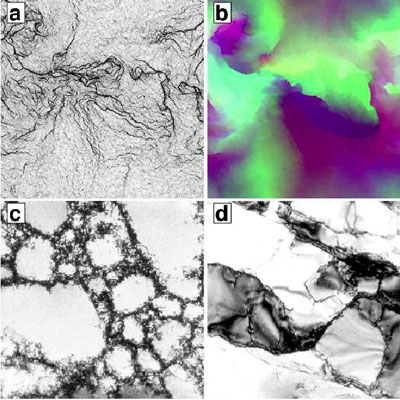Home > Press > Computer models explain patterns in bent crystals
 |
| pattern after strain. The bottom two are micrographs taken from a single copper crystal and single aluminum crystal after strain. |
Abstract:
Blacksmiths make horseshoes by heating, beating and bending iron, but what's happening to the metal's individual atoms during such a process? Cornell researchers, using computational modeling, are providing new insight into how atoms in crystals rearrange as the material is bent and shaped.
By Anne Ju
Computer models explain patterns in bent crystals
Ithaca, NY | Posted on September 3rd, 2010The researchers made computer-synthesized models of what such metals as aluminum and copper look like at the atomic level while being stretched, heated and cooled. They simulated how crystals, whose atoms start in a regular grid, transform as they are bent into different shapes.
Such new theories could lead to a better understanding of structural materials, from buildings to bridges, to make them less susceptible to tearing or breaking.
"We're really at the beginning stages of trying to develop a systematic theory of how materials evolve as we vary strain and temperature," said James Sethna, Cornell professor of physics, who leads the research.
The work is published in the Sept. 1 edition (Vol. 105 Issue 10) of Physical Review Letters, a publication of the American Physical Society.
When a single crystal is bent, portions of the crystal shift and create defects in the lattice called dislocations. The researchers found that their crystals exhibited starkly contrasting properties depending on temperature.
When hot crystals were bent, the dislocations arranged into grain boundaries, which are the places where lattice planes suddenly tilt. At low temperatures, the dislocations formed self-similar, random patterns known as fractals.
The work was funded by the Department of Energy and the National Center for Supercomputing Applications.
####
For more information, please click here
Contacts:
Media Contact:
Blaine Friedlander
(607) 254-8093
Cornell Chronicle:
Anne Ju
(607) 255-9735
Copyright © Cornell University
If you have a comment, please Contact us.Issuers of news releases, not 7th Wave, Inc. or Nanotechnology Now, are solely responsible for the accuracy of the content.
| Related News Press |
News and information
![]() Simulating magnetization in a Heisenberg quantum spin chain April 5th, 2024
Simulating magnetization in a Heisenberg quantum spin chain April 5th, 2024
![]() NRL charters Navy’s quantum inertial navigation path to reduce drift April 5th, 2024
NRL charters Navy’s quantum inertial navigation path to reduce drift April 5th, 2024
![]() Discovery points path to flash-like memory for storing qubits: Rice find could hasten development of nonvolatile quantum memory April 5th, 2024
Discovery points path to flash-like memory for storing qubits: Rice find could hasten development of nonvolatile quantum memory April 5th, 2024
Govt.-Legislation/Regulation/Funding/Policy
![]() NRL charters Navy’s quantum inertial navigation path to reduce drift April 5th, 2024
NRL charters Navy’s quantum inertial navigation path to reduce drift April 5th, 2024
![]() Discovery points path to flash-like memory for storing qubits: Rice find could hasten development of nonvolatile quantum memory April 5th, 2024
Discovery points path to flash-like memory for storing qubits: Rice find could hasten development of nonvolatile quantum memory April 5th, 2024
![]() Chemical reactions can scramble quantum information as well as black holes April 5th, 2024
Chemical reactions can scramble quantum information as well as black holes April 5th, 2024
Possible Futures
![]() Discovery points path to flash-like memory for storing qubits: Rice find could hasten development of nonvolatile quantum memory April 5th, 2024
Discovery points path to flash-like memory for storing qubits: Rice find could hasten development of nonvolatile quantum memory April 5th, 2024
![]() With VECSELs towards the quantum internet Fraunhofer: IAF achieves record output power with VECSEL for quantum frequency converters April 5th, 2024
With VECSELs towards the quantum internet Fraunhofer: IAF achieves record output power with VECSEL for quantum frequency converters April 5th, 2024
Academic/Education
![]() Rice University launches Rice Synthetic Biology Institute to improve lives January 12th, 2024
Rice University launches Rice Synthetic Biology Institute to improve lives January 12th, 2024
![]() Multi-institution, $4.6 million NSF grant to fund nanotechnology training September 9th, 2022
Multi-institution, $4.6 million NSF grant to fund nanotechnology training September 9th, 2022
Materials/Metamaterials/Magnetoresistance
![]() Nanoscale CL thermometry with lanthanide-doped heavy-metal oxide in TEM March 8th, 2024
Nanoscale CL thermometry with lanthanide-doped heavy-metal oxide in TEM March 8th, 2024
![]() Focused ion beam technology: A single tool for a wide range of applications January 12th, 2024
Focused ion beam technology: A single tool for a wide range of applications January 12th, 2024
Announcements
![]() NRL charters Navy’s quantum inertial navigation path to reduce drift April 5th, 2024
NRL charters Navy’s quantum inertial navigation path to reduce drift April 5th, 2024
![]() Discovery points path to flash-like memory for storing qubits: Rice find could hasten development of nonvolatile quantum memory April 5th, 2024
Discovery points path to flash-like memory for storing qubits: Rice find could hasten development of nonvolatile quantum memory April 5th, 2024
Construction
![]() Temperature-sensing building material changes color to save energy January 27th, 2023
Temperature-sensing building material changes color to save energy January 27th, 2023
![]() Strain-sensing smart skin ready to deploy: Nanotube-embedded coating detects threats from wear and tear in large structures July 15th, 2022
Strain-sensing smart skin ready to deploy: Nanotube-embedded coating detects threats from wear and tear in large structures July 15th, 2022
![]() A sunlight-driven “self-healing” anti-corrosion coating May 27th, 2022
A sunlight-driven “self-healing” anti-corrosion coating May 27th, 2022
![]() Polymer fibers with graphene nanotubes make it possible to heat hard-to-reach, complex-shaped items February 11th, 2022
Polymer fibers with graphene nanotubes make it possible to heat hard-to-reach, complex-shaped items February 11th, 2022
|
|
||
|
|
||
| The latest news from around the world, FREE | ||
|
|
||
|
|
||
| Premium Products | ||
|
|
||
|
Only the news you want to read!
Learn More |
||
|
|
||
|
Full-service, expert consulting
Learn More |
||
|
|
||








